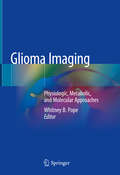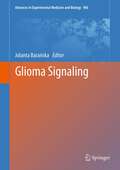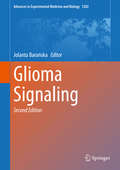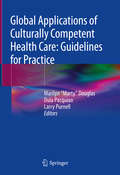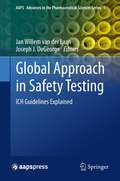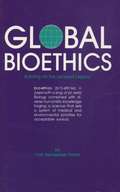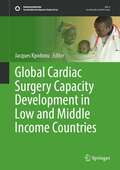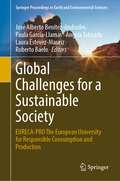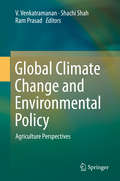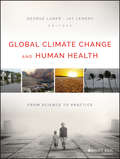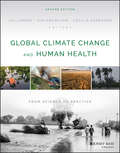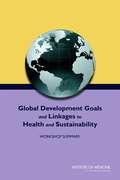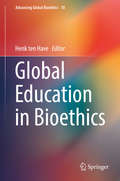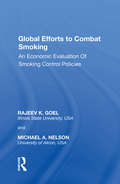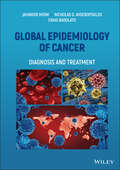- Table View
- List View
Glioma Cell Biology
by Aleksi Sedo Rolf MentleinGliomas are fatal diseases, but also represent good models for tumor research with the aim to eventually discover new and appropriate therapeutics against this disease. Glioma experimental research models are of help to investigate tumorigenesis (tumor stem cell theory versus "classical" opinions), tumor angiogenesis (since they are highly vascularized) and tumor invasion (since they grow without limits). In addition, they have a very special microenvironment (the brain) and limited tumor stroma cells (mainly microglia and endothelial cells). This book addresses the molecular mechanisms of the various tumor stages, describes the interaction with the tumor microenvironment and furthermore depicts experimental models for Glioma research and future therapeutic concepts. The book is composed and written for Scientists and Medical Doctors in Oncology, Neurosciences and Molecular Biology.
Glioma Imaging: Physiologic, Metabolic, and Molecular Approaches
by Whitney B. PopeThis book covers physiologic, metabolic and molecular imaging for gliomas. Gliomas are the most common primary brain tumors. Imaging is critical for glioma management because of its ability to noninvasively define the anatomic location and extent of disease. While conventional MRI is used to guide current treatments, multiple studies suggest molecular features of gliomas may be identified with noninvasive imaging, including physiologic MRI and amino acid positron emission tomography (PET). These advanced imaging techniques have the promise to help elucidate underlying tumor biology and provide important information that could be integrated into routine clinical practice. The text outlines current clinical practice including common scenarios in which imaging interpretation impacts patient management. Gaps in knowledge and potential areas of advancement based on the application of more experimental imaging techniques will be discussed. In reviewing this book, readers will learn: current standard imaging methodologies used in clinical practice for patients undergoing treatment for glioma and the implications of emerging treatment modalities including immunotherapythe theoretical basis for advanced imaging techniques including diffusion and perfusion MRI, MR spectroscopy, CEST and amino acid PET the relationship between imaging and molecular/genomic glioma features incorporated in the WHO 2016 classification update and the potential application of machine learningabout the recently adopted and FDA approved standard brain tumor protocol for multicenter drug trialsof the gaps in knowledge that impede optimal patient management and the cutting edge imaging techniques that could address these deficits
Glioma Signaling
by Jolanta BarańskaGlioma Signaling is a text reference on cellular signaling processes focused on the mechanism of nucleotide receptors activation by exogenic nucleotides and the formation of complex signaling cascades, including cytoplasmic transcription factors, induced by growth factors, cytokines and cannabinoids. The book provides a framework explaining how signal transduction elements may modulate glioma cytoskeleton structure, cytoplasmic calcium concentration changes, cellular growth, progression and invasion, as well as presents perspective concerning potential targets for glioma therapy.
Glioma Signaling (Advances in Experimental Medicine and Biology #1202)
by Jolanta BarańskaGliomas, developing in the brain from the transformed glial cells, are a very special kind of tumor, extremely refractory to conventional treatments. Therefore, for the development of new antitumor strategies, a better understanding of molecular mechanisms responsible for their biology, growth and invasion is still needed. This book is a reference on cellular signaling processes regulating gliomas physiology and invasiveness. The work is focused on the mechanism of nucleotide receptor activation by exogenous nucleotides and formation of complex signaling cascades induced by growth factors, cytokines and cannabinoids. The second edition of the book enriched in new chapters provides a framework explaining how signal transduction elements may modulate numerous genetic and epigenetic alterations, describes the role of local microenvironment in cellular growth, progression and invasion and, in the light of extensive new results, presents perspectives concerning potential targets for gliomas therapy.
Glissonean Pedicles Approach in Minimally Invasive Liver Surgery
by Benedetto Ielpo Edoardo Rosso Alessandro AnselmoAim of this book is to present the main minimally invasive approaches to the Glissonean pedicles. This kind of technique for hepatectomy has been gaining interest in recent years and may represent the ideal method to achieve anatomical liver resections. Currently the most performed procedure for liver surgery is still the classic intrafascial approach in which, after entering the Glissonean sheath, the portal triad elements are singularly dissected and isolated. However, this is a quite challenging technique to pursue in a minimally invasive setting. Nowadays the laparoscopic and robotic approach for liver resections are increasing worldwide and the intra or extra hepatic Glissonean approach, in which the portal triad elements are dissected and isolated “en bloc” without entering the Glissonean sheath, can facilitate the surgical technique. Furthermore this strategy allows better identification of the ischemic area and could decrease blood loss during dissection, as the liver inflow is kept under control. This book includes a step-by-step description of each pedicle isolation and section, with original laparoscopic and robotic pictures and videos. HPB surgeons who are interested in this technique may find these pages, written in cooperation with some of the most prominent worldwide experts, to be highly informative and valuable.
Global Applications of Culturally Competent Health Care: Guidelines for Practice
by Marilyn “Marty” Douglas Dula Pacquiao Larry PurnellThis book is unique in its global approach to applying the Guidelines for Culturally Competent Nursing Practice that were recently endorsed by the International Council of Nurses (ICN) and distributed to all of its 130 national nursing associations. The purpose of this book is to illustrate how these guidelines can be put into clinical practice and to show how practitioners from different countries with diverse populations can implement them. The first chapter provides the conceptual basis for Culturally Competent Health Care and describes how the guidelines were developed. Each of the next 10 sections presents a chapter describing a specific guideline followed by three or four chapters with detailed case studies to illustrate how the guideline was implemented in a particular cultural setting. All case studies follow a similar format and are written by international authors with clinical expertise and work experience in the culture being presented. This book will be useful for advanced practice nurses, healthcare students, clinicians, administrators, educators, researchers, and those who provide community health or population-based care.
Global Approach in Safety Testing
by Joseph J Degeorge Jan Willem van der LaanThis volume will consider one of ICH's major categories, Safety i.e. topics relating to in vitro and in vivo pre-clinical studies (Carcinogenicity Testing, Genotoxicity Testing, etc.). Since the start of the ICH process, many guidelines have been written, but even after ICH6 no explanations have been given during a formal Congress about the background of the ICH Guidance documents. Even more important than what has been written, might have been those thoughts of the experts that are not included in the Guidance documents. Why has the guideline been written as it is written, and why have some aspects been deleted. These and other related questions are the contents of this book, written by experts who were involved in the ICH process. Furthermore, the chapters will contain discussions on the "lessons learnt" and "future developments".
Global Bioethics: Building on the Leopold Legacy
by Van Rensselaer PotterThis book on Bioethics discusses regarding the Leopold legacy, human survival, dilemmas in ecological Bioethics, two kinds of bioethics, dilemmas in medical bioethics, the control of human fertility and global bioethics defined. Appendix includes the Leopold heritage and a bioethical creed for individuals.
Global Bioethics: The Impact of the UNESCO International Bioethics Committee
by Jonathan D. Moreno Alireza Bagheri Stefano SempliciThe UNESCO International Bioethics Committee is an international body that sets standards in the field of bioethics. This collection represents the contributions of the IBC to global bioethics. The IBC is a body of 36 independent experts that follows progress in the life sciences and its applications in order to ensure respect for human dignity and freedom. Currently, some of the topics of the IBC contributions have been discussed in the bioethics literature, mostly journal articles. However, this is a unique contribution by the scholars who developed these universal declarations and reports. The contributors have not only provided a scholarly up to date discussion of their research topics, but as members of the IBC they have also discussed specific practical challenges in the development of such international documents. This book will be suited to academics within bioethics, health care policy and international law.
Global COVID-19 Research and Modeling: A Historical Record (Data Analytics)
by Longbing CaoThis book provides answers to fundamental and challenging questions regarding the global response to COVID-19. It creates a historical record of COVID-19 research conducted over the four years of the pandemic, with a focus on how researchers have responded, quantified, and modeled COVID-19 problems. Since mid-2021, we have diligently monitored and analyzed global scientific efforts in tackling COVID-19. Our comprehensive global endeavor involves collecting, processing, analyzing, and discovering COVID-19 related scientific literature in English since January 2020. This provides insights into how scientists across disciplines and almost every country and regions have fought against COVID-19. Additionally, we explore the quantification of COVID-19 problems and impacts through mathematics, AI, machine learning, data science, epidemiology, and domain knowledge. The book reports findings on publication quantities, impacts, collaborations, and correlations with the economy and infectionsglobally, regionally, and country-wide. These results represent the first and only holistic and systematic studies aimed at scientifically understanding, quantifying, and containing the pandemic. We hope this comprehensive analysis will contribute to better preparedness, response, and management of future emergencies and inspire further research in infectious diseases. The book also serves as a valuable resource for research policy, funding management authorities, researchers, policy makers, and funding bodies involved in infectious disease management, public health, and emergency resilience.
Global Cardiac Surgery Capacity Development in Low and Middle Income Countries (Sustainable Development Goals Series)
by Jacques KpodonuThis book provides a focused resource on how cardiac surgery capacity can be developed and how it assists in the sustainable development and strengthening of associated health systems. Background is provided on the extent of the problems that are experienced in many nations with suggestions for how suitable frameworks can be developed to improve cardiac healthcare provision. Relevant aspects of governance, financial modelling and disease surveillance are all covered. Guidance is also given on how to found and nurture cardiac surgery curriculum and residency programs. Global Cardiac Surgery Capacity Development in Low and Middle Income Countries provides a practically applicable resource on how to treat cardiac patients with limited resources. It identifies the key challenges and presents strategies on how these can be managed, therefore making it a critical tool for those involved in this field.
Global Catastrophic Biological Risks (Current Topics in Microbiology and Immunology #424)
by Thomas V. Inglesby Amesh A. AdaljaThis volume focuses on Global Catastrophic Biological Risks (GCBRs), a special class of infectious disease outbreaks or pandemics in which the combined capacity of the world’s private and government resources becomes severely strained. These events, of which the 1918 influenza pandemic is emblematic, cause severe disruptions in the normal functioning of the world, exact heavy tolls in terms of morbidity and mortality, and lead to major economic losses. GCBRs can be caused by any type of microorganism, and myriad contextual factors can influence their impact. Additionally, there are cascading questions that arise in connection with GCBR prediction, preparation, and response. This book gathers contributions from thought leaders who discuss the multi-faceted approaches needed in order to address this problem. From understanding the special characteristics of various microbes to financing challenges, the volume provides an essential primer on a neglected but highly relevant topic. Physicians, scientists, policymakers, public health practitioners and anyone with an interest in the field of pandemics, emerging infectious disease, biosecurity, and global health security will find it a valuable and insightful resource.
Global Challenges for a Sustainable Society: EURECA-PRO The European University for Responsible Consumption and Production (Springer Proceedings in Earth and Environmental Sciences)
by José Alberto Benítez-Andrades Paula García-Llamas Ángela Taboada Laura Estévez-Mauriz Roberto BaeloEURECA-PRO is the global educational core hub and interdisciplinary research and innovation leader in qualitative environmental and social framework development for responsible consumption and production.Through its novel approach, on the one hand, it holistically contributes to the highly topical issue of Sustainable Consumption and Production under the umbrella of Sustainable Development Goal 12, and on the other hand it effectively contributes to the development of the European Higher Education Area complimentary to Sustainable Development Goal 4.In this book readers will find the discussion results among professionals, academics and scientists on responsible consumption and production, regarding the latest advances to achieve a sustainable society. This book contents 5 chapters focused on: Smart and healthy societies, Recycling, reused and longer lasting products, fresh air, clean water, healthy soil and biodiversity, cleaner energy and cutting-edge clean technological innovation, and industry 4.0.This book also intends to show the current and future challenges, and innovative solutions considering the technological, humanistic, educational, economic, social and environmental dimensions of sustainability
Global Challenges in Cardiovascular Prevention in Populations with Low Socioeconomic Status
by Tomás Romero Carolina Nazzal Nazal Fernando LanasCardiovascular Prevention (CVP) has included important technological advances and determined improvements in morbidity and mortality since the last 70 and 60 years. However, in populations with socioeconomic limited resources even basic health preserving tools such as access to a primary care provider and basic drug therapy for diabetes mellitus, high blood pressure, and high cholesterol are not within the reach of many. There is indeed limited information on the level of CVP available in low-income countries and even in similar segments of deprived populations from high income nations. More information is needed in the prevalence and outcomes in these socioeconomic groups on the major determinants of cardiovascular disease and death: hypertension, diabetes, obesity, heart failure, coronary heart disease, stroke, peripheral vascular disease, and multi-organ involvement. Moreover, in many countries (and not only in those with limited socioeconomic resources) basic preventive measures are still lagging behind (weight control, healthy diet, sedentary lifestyles, smoking cessation, alcohol use). In this book, contributors will review the prevalence of these risk factors as well as discuss possible remedial measures. In the different chapters, scientists from different countries and regions and with extensive research done in CVP in their respective fields will give their views on the status of CVP and suggest feasible remedial steps. Currently, there are many publications on the exciting and more recent developments in CVP, and the new directions undertaken (polygenic risk scores, primordial prevention, new antilipidemic and anti-inflammatory therapies, etc.). This book, in contrast, will go precisely in the opposite direction, defining the most basic and known effective CVP tools applied in the largest segment of the world’s population. This will be a valuable resource for students and professionals from different specialties, such as primary care providers, cardiologists, registered nurses, public health professionals, social workers, and economists. It will also be of interest to readers in the graduate and undergraduate levels. To ensure broad accessibility, an open access option is available for those with limited financial resources.
Global Child Health: A Toolkit To Address Health Disparities (Springerbriefs In Public Health)
by Krishnan Subrahmanian Padma SwamyThis timely resource brings child health to the forefront of global health and the crucial goal of universal equity of care. Its resource-based framework offers contemporary perspective on factors driving child health disparities, specific vulnerabilities of underserved children, and ways readers can become effective advocates for children. The book critiques current child health policy worldwide, examining both policies that are helping to alleviate and are contributing to further inequities. And the authors provide an extensive toolkit to aid professionals in multidimensional screening for child, newborn, maternal, and post-natal health as well as socioeconomic determinants of health. Included in the coverage:· What is global health? · The current state of global child health and disparities · Global health disparities in high-resource settings · Pathologies disproportionally affecting the underserved · Policy and advocacy framework · Navigating the domestic resources (an advocate’s well child check) Global Child Health will find a ready audience among child health providers (physicians, advanced practice providers, nursing staff, social workers, allied healthcare providers, public health professionals), medical educators (medical schools, departments of pediatrics, schools of public health, nursing schools and programs, schools of allied health), and child health policymakers (staff at USAID, Health and Human Services, health services researchers in child and global health policy, health advocacy-related nonprofit organizations).
Global Cleft Care in Low-Resource Settings
by David W. LowCleft lip and palate represents the most common congenital facial anomaly. Congenital anomalies are one of the top 10 causes of disability and suffering in many low and middle income countries (LMICs.) Further, an estimated 30% of the global burden of disease is treated primarily through surgery, and among surgical conditions, treating clefts conveys disproportionately large benefit relative to cost because suffering can be halted at a young age and deliver a lifetime of health. Over the last 50 years, cleft care has advanced in low-resource settings through international surgical missions and the efforts of sparse local providers. While exciting anecdotes of impact abound from these efforts, recent studies have identified a complication rate that often exceeds 50% and there is concern about the sustainability of foreign volunteer missions.This book serves as a thorough resource for providing medical and surgical care of cleft lip and palate deformities in low-resource settings, geared to the context of those settings. The content is consensus-based and evidence-based, with emphasis on treatment that is appropriate to a low-resource context and how this differs from that in higher-resource environments. It is authored by recognized cleft experts in close partnership with providers who practice in low-resource settings. It is heavily pictorially based through illustrative figures, photos and diagrams, to be facile for those who speak English as a second language. Following the introduction, Complete Cleft Care in Low-Resource Settings has six main sections: patient workup, surgical treatment, comprehensive care, educational innovation, care delivery models, and finally a series of illustrative case studies. Uniquely, the book’s breadth encompasses cleft care comprehensively, but does so through a practical “how to” format with many “from the field” examples of what has worked.
Global Climate Change and Environmental Policy: Agriculture Perspectives
by Ram Prasad Shachi Shah V. VenkatramananGlobal climate change threatens human existence through its potential impact on agriculture and the environment. Agriculture is climate-sensitive, and climate variability and climate change have net negative impact on it. Additionally, the agricultural landscape is affected by monoculture and agro-biodiversity loss, soil fertility depletion and soil loss, competition from biofuel production, crop yield plateaus and invasive species. Nevertheless, the global agricultural production system has to meet the food demands from the growing human population, which is set to exceed 10 billion by 2050. This book discusses the impacts of climate change on agriculture, animal husbandry and rural livelihoods. Further, since agriculture, forestry and other land-use sectors contribute about 10–12 gigatonnes of CO2-equivalent per year, it argues that agricultural policy must dovetail adaptation and mitigation strategies to reduce greenhouse gases emissions. This calls for a reformative and disruptive agricultural strategy like climate-smart agriculture, which can operate at all spatio-temporal scales with few modifications. The book also redefines sustainable agriculture through the lens of climate-smart agriculture in the context of the sustainability of Earth's life- support system and inter- and intra-generational equity. The climate-smart agriculture approach is gaining currency thanks to its inherent positive potential, and its goal to establish an agricultural system which includes "climate-smart food systems", "climate-proof farms", and "climate-smart soils". Climate-smart agriculture provides a pathway to achieve sustainable development goals which focus on poverty reduction, food security, and environmental health.
Global Climate Change and Human Health
by George Luber Jay LemeryLearn the foundations of climate science and human health Global Climate Change and Human Health examines the environmental crisis from a public health and clinical health perspective, giving students and clinicians the information they need to prepare for the future of health care. Edited by George Luber, associate director for climate change at the Centers for Disease Control and Prevention, and Jay Lemery, associate professor at the University of Colorado School of Medicine and section chief of Wilderness and Environmental Medicine in the Department of Emergency Medicine, and including chapters written by luminaries in the field, this landmark book provides a comprehensive introduction to climate change and health. Students will learn about climate changes direct effect on health, including extreme weather events, altered and degraded ecosystems, and threats to human security and welfare. Discussions on mitigation and adaptation strategies, including disease surveillance, communications, and greening health care, as well as a primer on the core concepts of climate change science are presented. Each chapter has a specific section on the clinical correlations of the impact of climate change on health. Informative illustrations depict increasing aeroallergens, shifting vector habitats, emergent risks, and more. Visual teaching materials broken down by chapter (including PowerPoint lecture slides) are available for instructors. This book shows how human health will be --and already has been -- affected and how health care practitioners need to start preparing. Understand the science behind climate change and climate variability Learn how the availability of food and clean water will affect public health Consider the diseases that will surge as vector populations swell Discover mitigation strategies targeted toward the health care community Understanding how climate change affects human rights and how international institutions are responding Increased temperatures bring algal blooms that threaten clean water. Degraded air quality brings allergies, asthma, and respiratory diseases. Ground pollutants lower the nutritional value of food crops. It's clear that climate change is very much a public health concern, and Global Climate Change and Human Health helps those preparing to be on the front lines of health care.
Global Climate Change and Human Health: From Science to Practice
by Jay Lemery Kim Knowlton Cecilia SorensonLearn more about the impact of global warming and climate change on human health and disease The Second Edition of Global Climate Change and Human Health delivers an accessible and comprehensive exploration of the rapidly accelerating and increasingly ubiquitous effects of climate change and global warming on human health and disease. The distinguished and accomplished authors discuss the health impacts of the economic, climatological, and geopolitical effects of global warming. You’ll learn about: The effect of extreme weather events on public health and the effects of changing meteorological conditions on human health How changes in hydrology impact the spread of waterborne disease and noninfectious waterborne threats Adaptation to, and the mitigation and governance of, climate change, including international perspectives on climate change adaptation Perfect for students of public health, medicine, nursing, and pharmacy, Global Climate Change and Human Health, Second Edition is an invaluable resource for anyone with an interest in the intersection of climate and human health and disease.
Global Climate Change, Population Displacement, and Public Health: The Next Wave of Migration
by Lawrence A. PalinkasThis timely text examines the causes and consequences of population displacement related to climate change in the recent past, the present, and the near future. First and foremost, this book includes an examination of patterns of population displacement that have occurred or are currently underway. Second, the book introduces a three-tier framework for both understanding and responding to the public health impacts of climate-related population displacement. It illustrates the interrelations between impacts on the larger physical and social environment that precipitates and results from population displacement and the social and health impacts of climate-related migration. Third, the book contains first-hand accounts of climate-related population displacement and its consequences, in addition to reviews of demographic data and reviews of existing literature on the subject. Topics explored among the chapters include: Hurricane Katrina and New Orleans Hurricane Maria and Puerto Rico The California Wildfires Fleeing Drought: The Great Migration to Europe Fleeing Flooding: Asia and the Pacific Fleeing Coastal Erosion: Kivalina and Isle de Jean Charles Although the book is largely written from the perspective of a researcher, it reflects the perspectives of practitioners and policymakers on the need for developing policies, programs, and interventions to address the growing numbers of individuals, families, and communities that have been displaced as a result of short- and long-term environmental disasters. Global Climate Change, Population Displacement, and Public Health is a vital resource for an international audience of researchers, practitioners, and policymakers representing a variety of disciplines, including public health, public policy, social work, urban development, climate and environmental science, engineering, and medicine.
Global Development Goals and Linkages to Health and Sustainability
by Institute of Medicine Board on Population Health and Public Health Practice Roundtable on Environmental Health Sciences, Research, and Medicine Erin RuschGlobal Development Goals and Linkages to Health and Sustainability is the summary of a public three-part webinar series hosted by the Global Environmental Health and Sustainable Development Innovation Collaborative between October and December, 2012. Experts within the fields of environmental and global health and members of government, academia, and civil society discussed global development goals that will focus on sustainable development to inform the Rio+20 post-2015 development agenda framework, which will likely be adopted at the September 2015 UN General Assembly. This report focuses on possible health-related measures and metrics that can be utilized for creating new Sustainable Development Goals as the Millennium Development Goals sunset in 2015, using existing measurements that can be adapted to track progress of global sustainable development and human health.
Global Education in Bioethics: Challenges In Global Bioethics (Advancing Global Bioethics #10)
by Henk Ten HaveThis book presents and elaborates on how the teaching of global ethics in healthcare contributes to furthering ideals of cosmopolitanism: solidarity, equality, respect for differences and concern with what human beings, and specifically patients have in common, regardless of where they live and who they are. Global problems such as pandemic diseases, disasters, lack of care and medication, homelessness and displacement call for global responses. The new area of global bioethics is providing answers by arguing that ethical discourse should first of all criticize the structures of violence and injustice that underlie many threats to global health. Education of health professionals should articulate that they are ‘citizens of the world’, like their patients. This book first demonstrates that a moral vision of global education is necessary to gain a global dimension. It is argued that a global framework of ethical principles is available; the challenge is to elaborate and specify that framework into specific educational approaches and models. The book subsequently analyzes goals and challenges of global education in biomedicine and healthcare. It is shown how such challenges (e.g. inequities and cultural differences) can be overcome. Finally, the book presents concrete examples (cases, methods, and practices) of global education in bioethics. The unique feature of the book is that it addresses global education challenges specifically in the area of healthcare, medicine, and medical science. It combines two areas of research and experience that are usually not connected: global bioethics and global education. This book is written for all those involved in global ethics teaching in medicine, nursing, ethics, philosophy, law, and theology courses.
Global Efforts to Combat Smoking: An Economic Evaluation of Smoking Control Policies
by Rajeev K. GoelTobacco is reported to be the second major cause of death in the world and there is ever-increasing interest in the costs of smoking, especially in the light of evidence of the health effects of second-hand smoke. This book brings together the findings of economists on the effectiveness of price and non-price policy initiatives to combat smoking and draws conclusions regarding the efficacy of the various policy measures. The authors evaluate the relative effectiveness of price-based smoking control policies (i.e. tax) in relation to non-price strategies (including advertising restrictions, sales restrictions, territorial restrictions and health warnings). They review evidence not only from the US but also from around the world, drawing important conclusions for developing countries where smoking is on the rise. The book will be essential reading for policy makers, health practitioners and researchers in health economics.
Global Epidemics, Local Implications: African Immigrants and the Ebola Crisis in Dallas
by Kevin J. ThomasHow fear and stigma affected the lives of African immigrants during the global Ebola epidemic—and the resilient ways in which immigrant communities responded.In December 2013, a series of Ebola infections in Meliandou, Guinea, set off a chain of events culminating in the world's largest Ebola epidemic. Concerns about the virus in the United States reached a peak when Thomas Duncan, a Liberian national visiting family in Dallas, became the first person to be diagnosed with Ebola and die of the disease on US soil. In Global Epidemics, Local Implications, Kevin J. A. Thomas highlights the complex ways in which disease outbreaks that begin in one part of the world affect the lives of immigrants in another. Drawing on information from a community survey, participant observations, government documents, and newspapers, Thomas examines how African immigrants were negatively affected by public backlash and their agency and resilience in responding to the consequences of epidemic. Ultimately, this book shows how these responses underscore the importance of immigrant resources for developing public health interventions.
Global Epidemiology of Cancer: Diagnosis and Treatment
by Jahangir Moini Nicholas G. Avgeropoulos Craig BadolatoGLOBAL EPIDEMIOLOGY OF CANCER Cancer is the second highest cause of death in the United States, and a leading cause of death globally. Our goals are to discuss the global epidemiology of various cancers, with detailed information on their prevalence, incidence, and clinical considerations. Epidemiology is the key to understanding the mortality and morbidity of cancer, and how we can prevent, diagnose, and treat the disease. Prevention of cancer is essential for saving lives. Prevalence and incidence of cancer are key factors that each government and population must be aware of. Advances in the study of cancer occur on a regular basis, and this book provides the latest insights about relationships between the disease and stem cells, tumorigenesis, molecular interactions, pathways, channels, and immunity. Global Epidemiology of Cancer: Diagnosis and Treatment meets the needs of readers by providing current information about epidemiology (including molecular epidemiology), diagnosis, and treatment. Providing logical, step-by-step information on various cancers, this book consolidates all of the most up-to-date information and data from verified studies on all different types of cancers in the United States and throughout the world. Chapters are presented so that each includes an overview, clinical manifestations, epidemiology, pathophysiology, etiology and risk factors, diagnosis, treatment, prevention, and prognosis. Global Epidemiology of Cancer: Diagnosis and Treatment will be invaluable to graduate and postgraduate students, including medical students; nurses; physician assistants; residents in oncology; public health students and allied health students.

